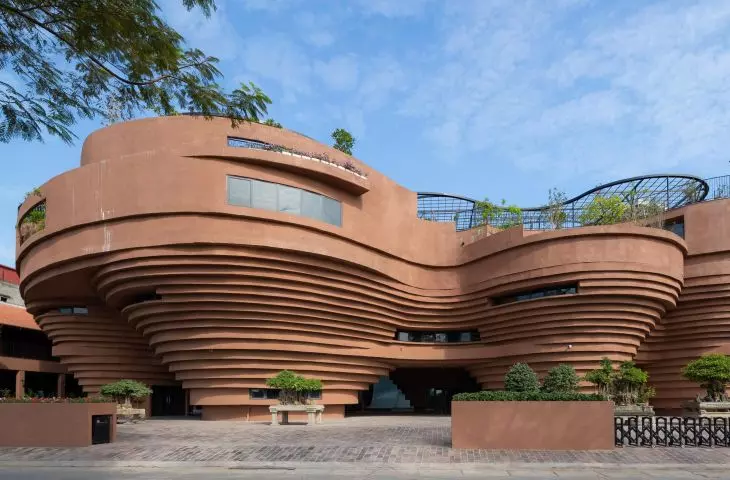The Bat Trang Ceramic Community Center,
design: 1+1>2 Architects
The Bát Tràng Ceramic Center by {tag:pracownie} opened in 2021, after three years of construction. The project, a showcase of arts and crafts and pottery techniques, reflects the village's rich history. Erected at a cost of 150 billion VND (Vietnamese dong, or about 23.4 million zlotys), the building is an important component of the Quintessential Vietnamese Craft Village Center, dedicated to preserving the 500-year-old tradition of pottery making.
The Bat Trang Ceramic Community House, aVND150 billion project, is an essential element of the "Center of the Essence of Vietnam's Artisan Village," dedicated to preserving 500 years of ceramic tradition
© 1+1>2 Architects
Bát Tràng Ceramics Village
- a new refuge of tradition
The Bát Tràng Ceramics Center, also known as the Bát Tràng Ceramics Village, is located in Gia Lam District, about 14 kilometers southeast of downtown Hanoi. With a history dating back to the 14th century, this place still plays an important role in the urban layout of the area today. The center faces the Bac Hung Hai canal and the Red River. The form of the building has been carefully considered - the density and height of the surrounding buildings have been taken into account, the building benefits from the panorama of the canal and recreates the vibrant space of the former pottery market.
Exterior view of the ceramic wall - the project is a demonstration of artistry and ceramic techniques
© 1+1>2 Architects
clay pots, pottery kiln?
- architectural inspirations
This five-story mixed-use complex draws inspiration from the tradition of ceramic production. Its architectural form is based on seven interpenetrating circles, the shapes of which were inspired by the silhouette of a potter molding clay. The curvilinear segments of the building gradually build up and expand with successive floors. The terraced forms have a functional dimension, with the individual circles forming stair treads or shelves for displaying pottery. From another perspective, the design resembles an ancient pottery kiln from Bát Tràng.
A view of the skylight in the clay interior - clay bricks, ceramic mosaic and ceramic tiles have been used extensively in the building, making full use of the materials characteristic of Bát Tràng, a village famous for its handicrafts
© 1+1>2 Architects
light and air conditioning Ceramics Center -
nature at the service of architecture
An open space on the second floor, created between seven inverted domes, is used for public events. Skylights in the roof provide natural daylight and cooling, allowing hot air to flow upward.
Interior depicting a ceramic staircase - clay bricks, ceramic mosaic and ceramic tiles have been used extensively in the building, making the most of materials characteristic of Bát Tràng, a village famous for its craftsmanship
© 1+1>2 Architects
The rustic charm of materials
Bát Tràng pottery village
The main theme is the reddish-brown color of the raw ceramics used to emphasize the rustic and idyllic nature of the pottery village. The façade of this building, which is unusual in form, was clad with reinforced concrete slabs, light enough to be constructed with the help of local builders. In addition, clay bricks, ceramic mosaic and tiles were used extensively in the building, making full use of materials characteristic of the artisan village of Bát Tràng.
A view of the terrace from outside - the open space on the second floor, created between these seven inverted domes, is used for public events
© 1+1>2 Architects
architectural genius on guarding
Bát Tràng's cultural heritage
The Bát Tràng Ceramics Center is not only a symbol of architectural genius, but also a living tribute to the traditions of Bát Tràng village, preserving its cultural heritage for future generations.
Aerial view - The Bat Trang Ceramics Center building fits in with the local architecture
© 1+1>2 Architects
Compiled by Natalia Ledzianowska
Illustrations provided courtesy of 1+1>2 Architects.










































































